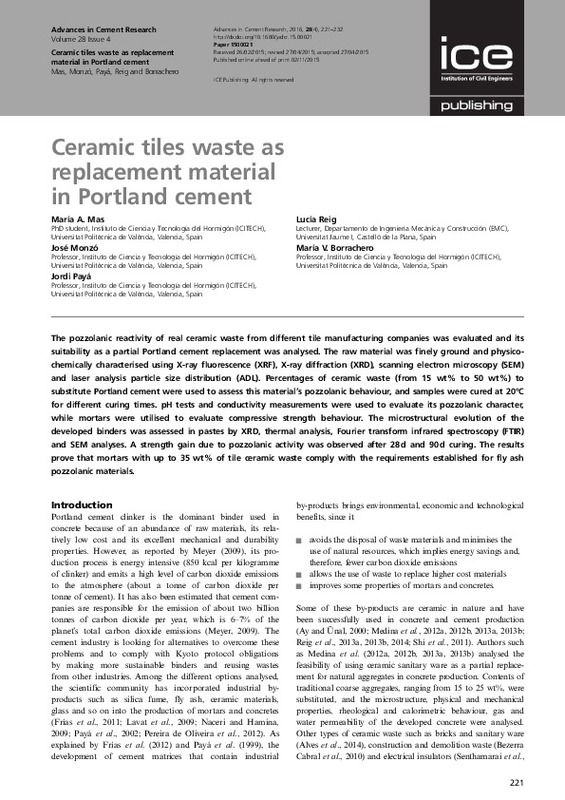JavaScript is disabled for your browser. Some features of this site may not work without it.
Buscar en RiuNet
Listar
Mi cuenta
Estadísticas
Ayuda RiuNet
Admin. UPV
Ceramic tiles waste as replacement material in portland cement
Mostrar el registro sencillo del ítem
Ficheros en el ítem
| dc.contributor.author | Mas, María A.
|
es_ES |
| dc.contributor.author | Monzó Balbuena, José Mª
|
es_ES |
| dc.contributor.author | Paya Bernabeu, Jorge Juan
|
es_ES |
| dc.contributor.author | Reig Cerdá, Lucía
|
es_ES |
| dc.contributor.author | Borrachero Rosado, María Victoria
|
es_ES |
| dc.date.accessioned | 2017-06-14T14:42:22Z | |
| dc.date.available | 2017-06-14T14:42:22Z | |
| dc.date.issued | 2016-04 | |
| dc.identifier.issn | 0951-7197 | |
| dc.identifier.uri | http://hdl.handle.net/10251/82850 | |
| dc.description | Permission is granted by ICE Publishing to print one copy for personal use. Any other use of these PDF files is subject to reprint fees. | es_ES |
| dc.description.abstract | The pozzolanic reactivity of real ceramic waste from different tile manufacturing companies was evaluated and its suitability as a partial Portland cement replacement was analysed. The raw material was finely ground and physicochemically characterised using X-ray fluorescence (XRF), X-ray diffraction (XRD), scanning electron microscopy (SEM) and laser analysis particle size distribution (ADL). Percentages of ceramic waste (from 15 wt% to 50 wt%) to substitute Portland cement were used to assess this material s pozzolanic behaviour, and samples were cured at 20°C for different curing times. pH tests and conductivity measurements were used to evaluate its pozzolanic character, while mortars were utilised to evaluate compressive strength behaviour. The microstructural evolution of the developed binders was assessed in pastes by XRD, thermal analysis, Fourier transform infrared spectroscopy (FTIR) and SEM analyses. A strength gain due to pozzolanic activity was observed after 28 d and 90 d curing. The results prove that mortars with up to 35 wt% of tile ceramic waste comply with the requirements established for fly ash pozzolanic materials. | es_ES |
| dc.description.sponsorship | The authors are grateful to the Spanish Ministry of Science and Innovation for supporting this study through project GEOCEDEM BIA 2011-26947, and also to FEDER funding. | en_EN |
| dc.language | Inglés | es_ES |
| dc.publisher | Thomas Telford (ICE Publishing) | es_ES |
| dc.relation.ispartof | Advances in Cement Research | es_ES |
| dc.rights | Reserva de todos los derechos | es_ES |
| dc.subject.classification | INGENIERIA DE LA CONSTRUCCION | es_ES |
| dc.title | Ceramic tiles waste as replacement material in portland cement | es_ES |
| dc.type | Artículo | es_ES |
| dc.identifier.doi | 10.1680/jadcr.15.00021 | |
| dc.relation.projectID | info:eu-repo/grantAgreement/MICINN//BIA2011-26947/ES/REUTILIZACION DE RESIDUOS CERAMICOS Y DE DEMOLICION EN LA PREPARACION DE NUEVOS MATERIALES GEOPOLIMERICOS/ | es_ES |
| dc.rights.accessRights | Abierto | es_ES |
| dc.contributor.affiliation | Universitat Politècnica de València. Escuela Técnica Superior de Ingenieros de Caminos, Canales y Puertos - Escola Tècnica Superior d'Enginyers de Camins, Canals i Ports | es_ES |
| dc.description.bibliographicCitation | Mas, MA.; Monzó Balbuena, JM.; Paya Bernabeu, JJ.; Reig Cerdá, L.; Borrachero Rosado, MV. (2016). Ceramic tiles waste as replacement material in portland cement. Advances in Cement Research. 28:221-232. https://doi.org/10.1680/jadcr.15.00021 | es_ES |
| dc.description.accrualMethod | S | es_ES |
| dc.relation.publisherversion | http://dx.doi.org/10.1680/jadcr.15.00021 | es_ES |
| dc.description.upvformatpinicio | 221 | es_ES |
| dc.description.upvformatpfin | 232 | es_ES |
| dc.type.version | info:eu-repo/semantics/publishedVersion | es_ES |
| dc.description.volume | 28 | es_ES |
| dc.relation.senia | 325600 | es_ES |
| dc.contributor.funder | Ministerio de Ciencia e Innovación | es_ES |
| dc.contributor.funder | European Regional Development Fund | es_ES |








